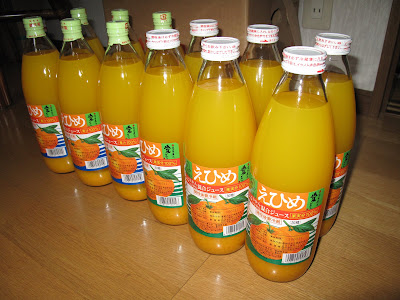The orange story
During the golden week, we travelled to Kyushu and Shikoku and met a fantastic family, on the ferry from Oita to Matsuyama. The Kimuras live in the Ehime prefecture in Shikoku and run an electrical appliance business there. I guess we were extremely lucky that day, because they are some of the nicest folks we've ever met in Japan - extremely warm and down-to-earth. It reaffirms the popular Japanese belief that the southerners are the friendliest lot in Japan.
Even though we had to bid farewell to them at the end of the 3.5 hour ferry ride, our friendship didn't just stop there. Little did we know that a pleasant surprise was in store for us when we got home. A day after we returned to Owase, we received from them a carton (12 large bottles no doubt) of 1-litre mandarin orange (mikan) juice that the Ehime prefecture (where the Kimuras are from) is famous for. It's really amazing how a first meeting which lasted only a few hours could invite such generousity from them. It really is. And, that mikan juice is one of the best I've ever had in my life.
Japan produces a hundred types of mikan. Gigantic, large, mid-sized, small, tiny, sweet, sour, soursweet, sweetsour - you name it, you have it here. All these mikan have different names. The ones in Ehime, known as iyokan, are supposed to be one of the sweetest types you can find. Ehime is extremely proud of its mikan juice, so proud that its largest mikan juice producer named itself POM juice, meaning juice of NIPPON (Japan). At the Matsuyama airport, all you need to do is to turn on the taps to get free mikan juice. I once watched a TV programme that people buy POM juice by the carton, not by the bottle in the Ehime prefecture. There are all sorts of dishes that are made using mikan juice, the most popular being the mikan juice rice.
Actually, Owase is also famous for a type of mikan called the amanatsu (literally means sweet summer) - but it tastes far from sweet. I think it tastes similar to the grapefruit. People tell us it's not that bad, because amanatsu's cousin - natsu (literally summer) - tastes ten times worse. To say that mikan is in abundance in the area we live in is an understatement. Often we see so much mikan rotting on the ground and there's nothing we can do because it's illegal picking fruit that does not belong to you.
It's the amanatsu season now, and so far we've received quite a lot of amanatsu. No matter how sour, free fruit (or rather food) is always welcomed.:) Just last Friday, we received a bottle of handmade orange marmalade, which I believe is made from amanatsu.
At the TanTans, free food always present the opportunity for new food creations. With our bunch of orange freebies, we made an orange sorbet and some orange bread topped with the marmalade.




Even though we had to bid farewell to them at the end of the 3.5 hour ferry ride, our friendship didn't just stop there. Little did we know that a pleasant surprise was in store for us when we got home. A day after we returned to Owase, we received from them a carton (12 large bottles no doubt) of 1-litre mandarin orange (mikan) juice that the Ehime prefecture (where the Kimuras are from) is famous for. It's really amazing how a first meeting which lasted only a few hours could invite such generousity from them. It really is. And, that mikan juice is one of the best I've ever had in my life.
Japan produces a hundred types of mikan. Gigantic, large, mid-sized, small, tiny, sweet, sour, soursweet, sweetsour - you name it, you have it here. All these mikan have different names. The ones in Ehime, known as iyokan, are supposed to be one of the sweetest types you can find. Ehime is extremely proud of its mikan juice, so proud that its largest mikan juice producer named itself POM juice, meaning juice of NIPPON (Japan). At the Matsuyama airport, all you need to do is to turn on the taps to get free mikan juice. I once watched a TV programme that people buy POM juice by the carton, not by the bottle in the Ehime prefecture. There are all sorts of dishes that are made using mikan juice, the most popular being the mikan juice rice.
Actually, Owase is also famous for a type of mikan called the amanatsu (literally means sweet summer) - but it tastes far from sweet. I think it tastes similar to the grapefruit. People tell us it's not that bad, because amanatsu's cousin - natsu (literally summer) - tastes ten times worse. To say that mikan is in abundance in the area we live in is an understatement. Often we see so much mikan rotting on the ground and there's nothing we can do because it's illegal picking fruit that does not belong to you.
It's the amanatsu season now, and so far we've received quite a lot of amanatsu. No matter how sour, free fruit (or rather food) is always welcomed.:) Just last Friday, we received a bottle of handmade orange marmalade, which I believe is made from amanatsu.
At the TanTans, free food always present the opportunity for new food creations. With our bunch of orange freebies, we made an orange sorbet and some orange bread topped with the marmalade.






